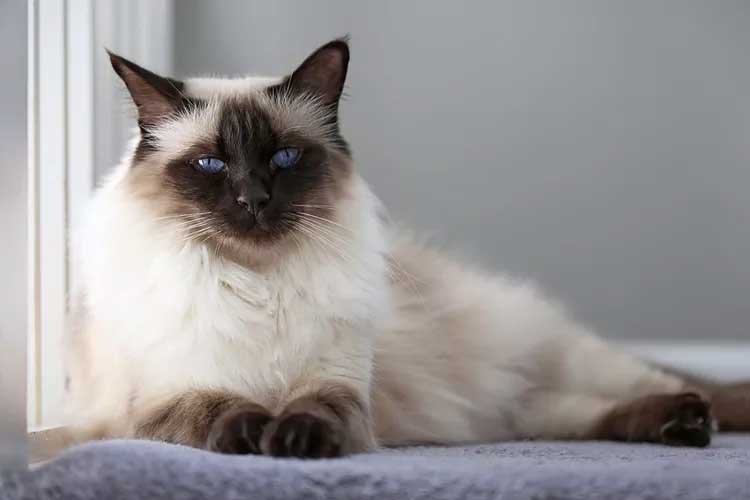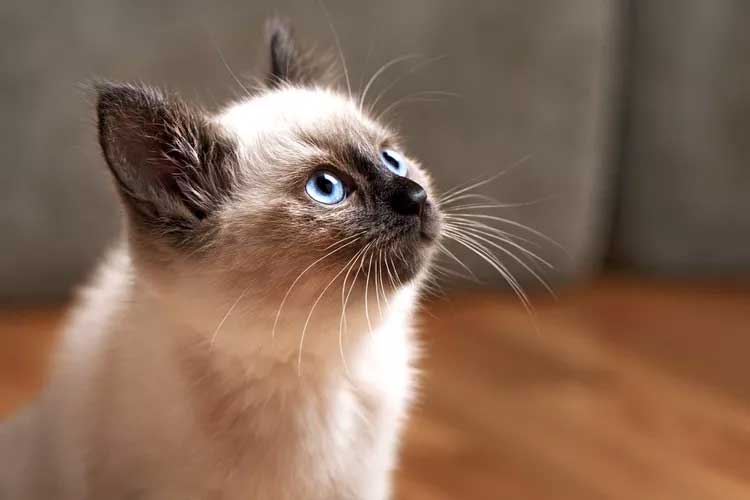Combining everything people love about the Siamese with a soft coat of luscious, long hair, the Balinese is a luxurious take on an already popular breed.

Balinese Overview
| OFFICIAL NAME | Balinese |
| COMMON NAME | Balinese (long-hair Siamese) |
| PET HEIGHT | 8 to 11 inches |
| PET WEIGHT | 8 to 15 pounds |
| LIFESPAN | 15 to 20 years |
| GOOD WITH | children, families, seniors |
| TEMPERAMENT | affectionate, sociable |
| INTELLIGENCE | high |
| SHEDDING AMOUNT | normal |
| PLAYFULNESS | high |
| ENERGY LEVEL | active |
| VOCAL LEVEL | frequent |
| COAT LENGTH | long |
| COLORS | blue / gray, chocolate / brown / sable, cream / beige / tan, fawn, lilac, red / orange, white |
| PATTERNS | color point |
| OTHER TRAITS | friendly toward humans, friendly toward strangers, good for first-time pet owners, good lap cat, requires lots of grooming, strong loyalty tendencies, tolerates being alone |
The Balinese cat is a variation on the traditional Siamese cat breed that features everything people love about the older breed, but in a fluffier package. The Balinese's long, silky coat is his hallmark—in fact, it's the very reason for the breed's existence.
Coat notwithstanding, Balinese are everything you know and love about the Siamese: playful, highly intelligent, incredibly devoted to their family units, and engaging conversationalists.
Appearance
The Balinese is, more or less, a floofy Siamese. He's got a medium-to-long silky coat that resists matting and lies close to his body, accentuating his lean physique. This coat is white or cream and color-pointed similarly to the Siamese in the same traditional colors: blue, chocolate, seal, and lilac. Their tails are plumed or rigid, with hair that matches the rest of their points.
Physically, Balinese cats are lithe, delicately built cats with strong hind legs that make them terrific jumpers (don't be surprised to find yours looking down at you from the top of your kitchen cabinets). They have neat, oval feet and wedge-shape heads; their large ears are set far enough apart to continue the head's wedge shape. Balinese eyes are almond-shaped and a brilliant, clear sapphire.
Temperament
In virtually every way aside from coat, when you adopt a Balinese, you're getting a Siamese. What this means from a personality standpoint is that you're getting a devoted, loving companion who adores being around his humans as much as possible. He will follow you from room to room, engaging in deep conversation the whole time."They carry very similar traits [to the Siamese], because they have such a close lineage," says Lin Kauffman, DVM, of the Prairie View Animal Hospital in Grimes, Iowa. "If you don't want a cat that doesn't have to have the last word, don't have a Siamese, don't have a Balinese."

While Balinese cats do tend to be just as vocal as their Siamese cousins, they also tend to have a softer tone, which makes them somewhat more affable for people with roommates or close living situations.
As an adoring and intelligent cat, the Balinese will keenly observe everything you do and follow you around the house. Chyrle Bonk, DVM at Pet Keen, says these furry brainiacs are also capable of learning cool tricks and playing games, and they'll make sure you treat them with the attention they deserve.
"They can be a little demanding of your time and speak out if you aren't giving them enough attention," Bonk says. "Don't expect to get one of these cats and simply plan to feed and clean up after them. They will want more from you than that."
Living Needs
The Balinese is a "vertical cat"—aka, they're likely to scale the curtains and jump on top of your refrigerator. To make these kitties happy (and make sharing your home go smoothly), invest in a few high-up perches like cat trees, hammocks, and shelves."While they might not want to go around the clock, they do like to play for large parts of the day," Bonk says. Because Balinese cats are so playful, Bonk says they make great playmates for children and can get along well enough with other pets. "Most will be accepting of other pets, especially if they're properly socialized beforehand," she says. "But don't expect them to be welcoming to other animals if they aren't used to them."
If left alone for extended periods, they don't tend to suffer from separation anxiety so much as boredom. The results for your furniture, however, may be the same, so make sure to leave out lots of toys whenever you're away from home. And although they're active cats and deeply enjoy their daily playtime, they also make great lap cats and are happy to simply be wherever their human companions are.
Care
While the Balinese are furry and fairly regular shedders, there's some evidence to suggest that they produce a lower amount of the Fel d1 and Fel d4 protein allergens. While this does not technically make them absolutely hypoallergenic cats, it does suggest that they may be a better pet for people with allergies than other long-hair breeds. But before bringing home a Balinese kitten, spend some time with the breed to see how your allergies react.That being said, a regular brushing is going to be part of your grooming routine with a Balinese cat. Bonk says the breed doesn't have an undercoat, so grooming isn't anything excessive—all you need to do is stay on top of any snarls and tangles. The Balinese's large ears will need regular cleaning to prevent ear infections and excessive wax buildup, Bonk says, and he'll also need his nails trimmed.
More than grooming, the biggest responsibility of Balinese pet parents is to make sure their cat is getting enough attention (and adoration).
"This is not a cat that is going to quietly go about their business," Bonk says. "They will want to be involved in everything you do. Expect to give them lots of attention in the form of playing as well as affection. If they don't get what they want for you, expect some retribution in the form of [undesirable behavior] or vocalization."
Health
The Balinese are a relatively healthy breed with a long lifespan of 15–20 years. They are, however, susceptible to similar health conditions as the Siamese, Bonk says.
Balinese cats can have a number of eye issues, including progressive retinal atrophy (PRA), which is a degeneration of the retina in the eye. Cats with PRA can become near- or far-sighted over time, or even blind. Balinese cats can also be cross-eyed, Bonk says.
Dilated cardiomyopathy, a disease that enlarges the heart muscles and decreases heart function, is another potential issue. There is also some concern that they are at a low risk for hypertrophic cardiomyopathy (HCM). The breed can also be at increased risk for liver amyloidosis, which eventually leads to liver failure.
Bonk says the Balinese may also be more susceptible to respiratory problems as well, specifically asthma.
History
There is evidence to suggest that long-haired Siamese kittens have been appearing randomly in litters since at least the early 19th century. Long considered to be exhibiting an undesirable recessive gene, these long-haired Siamese kittens were traditionally neutered and given away as pets.By the early 20th century, some breeders began to appreciate the long-haired Siamese and began keeping them to show. The American Cat Fanciers' Association first registered "long haired Siamese" to show in 1928, though they were, as the name suggests, considered to be Siamese cats and not a separate breed.
By the 1950s, breeders had begun working in earnest to establish the cats as their own breed, and the long-haired cats were given their name by Balinese breeder Helen Smith. The breed was recognized for championship by the CFA 1970.
Fun Facts
The name "Balinese" was chosen to separate this breed from its Siamese ancestors and because the cats' graceful bodies and long, silky coats reminded breeder Helen Smith of a Balinese dancer.The Balinese is classified as a rare breed and ranks 35th in popularity of the 41 breeds recognized by the Cat Fanciers' Association.
To ensure the consistency of their bloodlines, only registered, purebred Siamese were allowed in the Balinese breeding program.